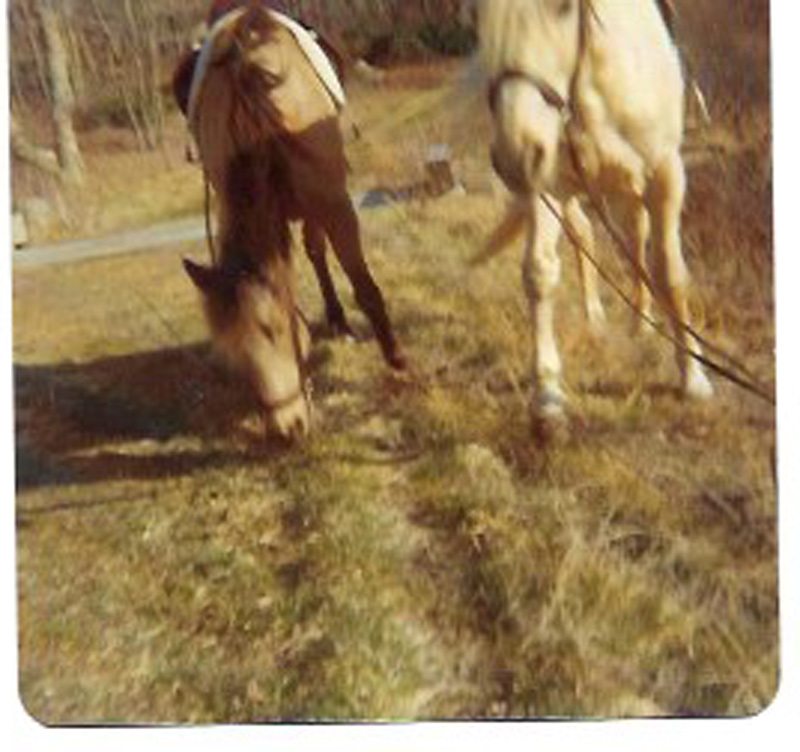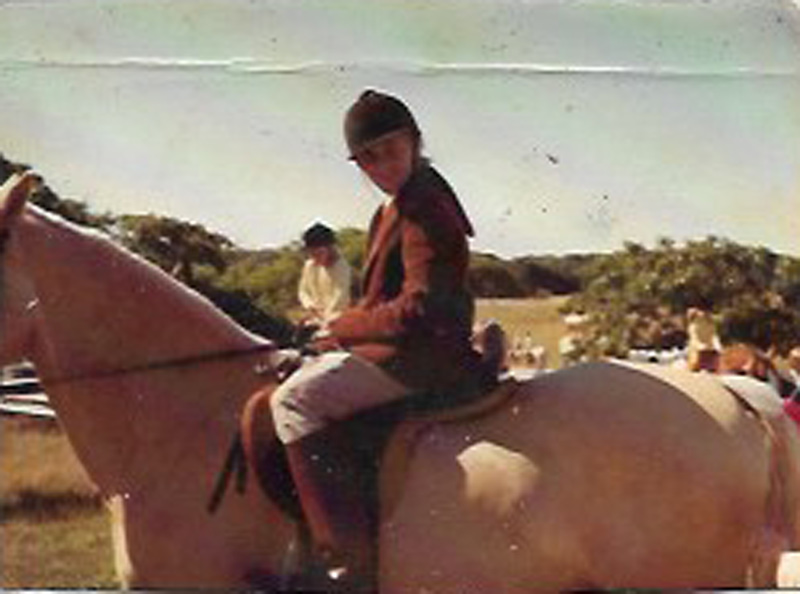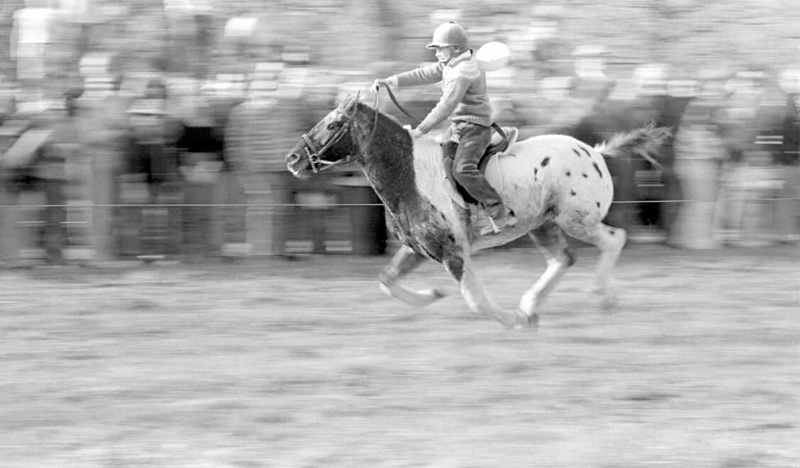I was introduced to horses at 6, when my father’s girlfriend at the time, Nancy Safford, took me to Nip ’n’ Tuck Farm for lessons. I rode a rowdy Shetland pony named Roxy. Roxy was smart and athletic, and promptly scraped me off his back by slipping under a fence, then proudly trotted back to the barn. I have no doubt I was just another conquest for this clever, sassy pony.
A few years later, I met my soon-to-be best friend Beach Phillipps, who had just moved with her family to the Island from New York City. I introduced Beach to horses when we were 9; we’d hitchhike to Nip ’n’ Tuck Farm in West Tisbury on Saturdays with five bucks so we could take a trail ride with a young Freddy Fisher.
It was the ’70s, and the Island wasn’t quite so precious. We could ride pretty much anywhere without the fear of being called trespassers. My pony was named Lady, a pony you might expect to see out West in the Plains, herding cattle. Lady was dun-colored — a warm, dark tan with dark brown mane and tail. Beach rode Sundance, a beautiful palomino who was a former parade horse with a flowing mane and a tail that matched Beach’s blond locks.
Freddy led us on our rides on his strikingly beautiful, very well-trained, light gray Arabian named Muffet Kusna.
Those Saturdays were filled with unfettered happiness and fantasy as we rode through the backwoods and fields of West Tisbury. Time just disappeared, and by the end of our ride, we were already excited about the next Saturday. As we got comfortable at the farm, Saturdays became longer, and we stretched our time out learning horsemanship. We learned to brush and groom the horses, lift their heavy hooves, and pick out the dirt. We learned how to tack up — putting on a bridle and saddle. And after our ride, we learned to untack, brush the horses down, and return them to their stalls. There were other horses on the farm we got to know. Mr. Fisher had a team of chestnut-colored draft horses named Bob and Barney. Frosty was a skittish ex-racehorse we were a bit afraid of; we learned it was best to observe his nervous energy from afar. There was Freddy’s magical horse, Kusna, whose stall was at the open door to the lower level of horse stalls. She seemed in charge of the whole group. Upstairs with the cows were the smaller ponies, a chocolate brown Shetland pony named Gemini, and of course the infamous Roxy.

By the time summer came, we had worked our way into the farm system, and spent days riding and helping out at the barn. We helped mostly with trail rides, tacking horses up, and riding at the back of the group as people were led out through the woods on horseback. At the end of the summer, Mr. Fisher — Fred — offered Beach and me the opportunity for a free winter lease with Lady and Sundance. This was a win-win; Mr. Fisher would not have to feed the horses all winter, and we got to have Lady and Sundance at our homes and ride every day, which we did.
My father created a small stall in his workshop for Lady, and put fencing around the field below our house. Beach had an old shed that was converted for Sundance, and they also were able to fence in a pasture area.
We were inseparable, the four of us. If I slept over at Beach’s house, which I did quite often, Lady slept there too. After school, we would go to our homes, tack up, and meet for a ride. We lived about half a mile from each other, me on Music Street, Beach behind the gas station. We would meet in the middle, and head into our special world in the woods. Even with cold, snowy days, there was no stopping us. We would put Vaseline on Lady’s and Sundance’s hooves to prevent snow from balling up in them; we would ride bareback to stay warm.
Lady preferred to be with Sundance, and eventually learned how to stretch our fencing by leaning her body on the wire until it became loose. Then she could slip out and escape to see her best friend.
When we got off the school bus near Alley’s Store, an adult would often tell us they saw Lady running down Music Street heading toward the gas station. It wasn’t ideal, but Lady was a pony — smart and willful.
After another summer at Nip ’n’ Tuck, Beach and I were official barn rats, riding in exchange for taking out trail rides, grooming, and mucking stalls. We would spend full days on the farms. By summer’s end, Mr. Fischer offered to sell Sundance to Beach for $250, and Beach accepted the deal. Sundance had issues: He was often lame, and not always a reliable trail horse. Lady was very sturdy, and was not offered for sale. The bright side was I got to have Lady at my house again, and our riding adventures continued.
The following summer Beach and I were no longer riding together, as my only chance to ride Lady was to ride at Nip ’n’ Tuck on my own, continuing as a barn rat. It was lonely.
That winter was seventh grade and my life changed when my father began working and living in Key West. My brother and I joined my father, and in addition to all the obvious changes, there were no horses.

When we returned to the Vineyard in the spring, every girl I knew was riding horses. Our horse gang in West Tisbury all moved to Pond View Farm, off New Lane on the Tisbury Great Pond. We had gone from being trail riders to serious riders, taking lessons, learning true equitation and skilled horsemanship, and competing in local horse shows.
The land that Pond View Farm is on was owned by Daniel Manter, known as “Dan’l” — an Island builder who built and founded the Manter Memorial Hostel with his wife Lillian in 1955. Dan’l’s daughter, Marjorie Manter Rogers, was an avid horsewoman, and ran the old riding stable for years in the mid-’70s before passing the reins of daily operations over to her niece, Martha Kenniston. I remember Martha doing a fine job of balancing being a boss, teaching riding, being a 4-H leader, a mentor, and creating a fun, casual environment where she was just one of the girls who loved horses.
Pond View had many horses, ponies, and many girls of all ages, and I remember just one boy who hung out at the farm. We taught riding lessons, and took customers out on trail rides as part of our work. And we competed throughout the summer in horse shows. We spent full days at the farm, morning until the evening feeding. There was an hour off for lunch, and if we were able, we would bum a ride with one of the older girls to Alley’s Store to grab a bag of Doritos, a Pepsi, and a Snickers bar. Otherwise, we would hang out in the grain bins, chewing on molasses-covered oats and corn.
We worked hard, and by my memory, got along pretty well.
Beach had brought Sundance to Pond View for the summer, and I was given a pony named Chocolate Chip to ride and show. He seemed fancy compared to my rustic pony Lady; he was well-trained and a nice mover. It was a fun time. I rode him English, Western, jumped him, and even showed him sidesaddle. He was a pony who could do anything. I always did well competing on him.
By the next season, after outgrowing Chocolate Chip (or maybe my turn with a perfect pony was up), I was offered a skittish new pony Marjorie brought to the farm. He was a large Appaloosa pony named Raisin.
Raisin must have been abused in some way — he had serious trust issues. Though I was still small and scrawny for my age, I was also very strong, and able to handle most complicated ponies. I was happy for the challenge of earning Raisin’s trust.
Raisin was large, and had a little rat tail and shaggy, fuzzy feet, which he hated to have touched, another sign he had probably been abused. He was athletic and fast, and could jump. He wasn’t fancy at all, but he was fun and very sweet. I loved him.
Horses have a doglike bond with their people, and can be affectionate and sweet, responding with visible happiness the way a dog does, but with different gestures — maybe shaking their head, twitching their ears, and giving a sweet whinny when they see you. They lean into a good brushing or scratching. They nuzzle their soft, velvet noses on their people, they playfully rub their faces on your back. Horses are partners in sync with their person, whether working on a farm or range, show jumping in a ring, pirouetting in a dressage arena, or cantering through an open field.
Horses can also feel our fear and anger. Horses become damaged when abused, and like a dog, can become defensive, distrustful, and appear to be mean.

After a time, Raisin trusted me, and others too. He finally had well-groomed feet, and relaxed, knowing he was safe and cherished.
When I was 15, Raisin’s owner, Marjorie, asked me to race Raisin in the Thanksgiving weekend horse race. The Thanksgiving weekend horse race was started back in 1971 by John and Kappy Hall at their property in West Tisbury. It was a hodgepodge of horses, riders, families, and fun seekers. This was a homespun Vineyard event: no worries; just food, drinks, and friends. Fred Fisher was there with draft horses Bob and Barney pulling his hay cart, loaded with screaming, happy, not heavily supervised kids. The actual race was just a sprint from one end of the field to the other, not a classic race around a track.
Cars and people lined the field, and a group of riders held their excited horses as much as possible at a starting line, and then galloped to the other end.
After several years, the race had moved near Scrubby Neck Farm — perhaps the risk became too much for the Halls to keep hosting such a loose event, which was mostly a big party with horses running at full speed. (What could go wrong?)
When the chance came to ride Raisin in the race, I was excited to take my spotted pony to compete in an event that I had first watched on my father’s shoulders when I was 7 years old. I knew Raisin was fast, and I trusted his surefootedness. I knew he would not fall. I knew he would keep me safe.
On the morning of the race, Beach’s sister Christy and I rode from Pond View Farm along Edgartown–West Tisbury Road the few miles to the racing field. Christy would be riding her chestnut mare named Chyenne in the race. There was a good crowd; the November air was cold. Ten horses were entered in the race, or should I say nine horses and Raisin, who was actually a large pony.(Horses are measured in “hands,” which are equivalent to four inches. Ponies measure under 14.2 hands.) Most riders who compete will tell you: You may have nerves, but you cannot afford to be fearful on the back of a large, strong, and psychic beast. Adrenaline pushes you beyond fear. I was excited.
The race lasted seconds — so fast I don’t remember it. Raisin and I came in third out of the 10 riders.
After that year, our days with horses faded out. The next summer, full-on high school life set in, becoming more social, with summer jobs and field hockey in late August. It was a natural progression at the time: We all needed to make money and move into living as young adults.
When I think back on my childhood, I think about how much horses protected me and helped me grow up. We all felt responsibility; it kept us girls focused, grounded, and accountable. It was our first real-life commitment.
Of course, times have changed, and horse life is expensive, with a lot more oversight, like all sports. We were lucky to be latchkey kids. After hours at the barn, we returned home at dark. Nobody asked us what we did all day. Nobody worried that it might be dangerous.
Those freedoms have dwindled, and our horse gang movd on. I would tell any parent to this day: If your daughter wants to ride, try to make it happen. Give her the gift of learning how strong and independent she is, and what a good friend she can be.
One more thing: After Beach finished college and world travel, she circled back to horses, and spent her adult life as a gifted dressage rider, trainer, life teacher, and lover of horses up until her death of cancer at 50 years young. She touched many young and old riders alike with her passion for and deep understanding of horses.

